Вяч. Вс. ИвановTabula Cortonensis
|
1. TABULA
CORTONENSIS
(FOUND IN 1992,
Cortona)
 |
 |
| Сторона A | Сторона B |
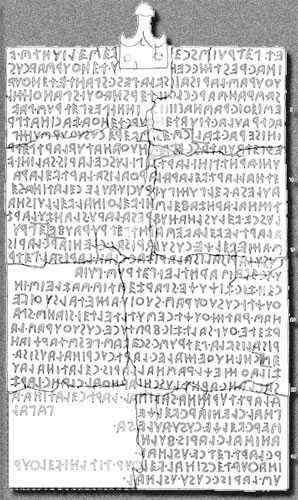 |
 |
| Сторона A | Сторона B |
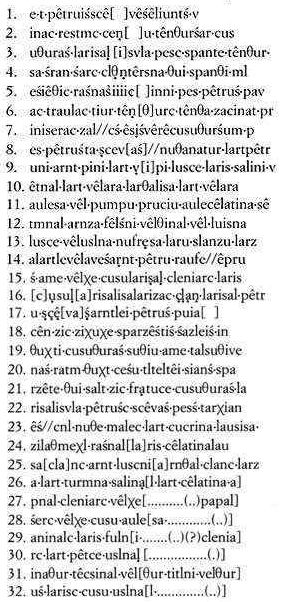 |
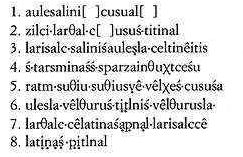 |
|
Сторона A |
Сторона B |
Иллюстрации взяты с
http://www.comune.firenze.it/soggetti/sat/tabula/,
http://www.geocities.com/Athens/Crete/4060/cortuna.html
The
sections and texts of separate parts are cited according to: Luciano
Agostiniani, Francesco Nicosia, Tabula Cortonensis. Studia Archaelogica 105.
Roma: "L'Erma" di Bretschneider,
2000. References
to Pfiffig, A.J. :
Die Etrmkische Sprache, 1969.
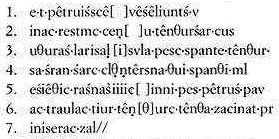
Summary:
several rites and/or donations are considered obligatory for Petru Scêvê and
a group of people called respectively by a collective Cusu-θura-ś (for
the form cf.
paχaθ-ur "servants
of the cult of Bacchus, bacchanti"; tamia-θur "service"
from tamia-) to which a form laris-a[i]svla is joined.
et/θ...cên-u
"Thus (=in this way) a [certain
rite] with the use of (a sacrificial table? Etr. êliun,
cf. Gk.
ελεόν; Etr.
Ergative- "Ablative" in —tś )
and (-c) wine (vina, vine?)
and ... should
be performed"
(similar
constructions in {et/ θ>...+Verbal stem +-u} occur in the
tablet of Capua). The following lines contain tênθ-ur "prescribed,
predetermined rite". The word is repeated 3 times: 2
times in constructions with numerals, the third time in figura
etymologica tênθ-ur-c.
tênθ-a "and
a prescribed (rite) has been determined" (see on tênθ-a-s
"eingesetzt" Pfiffïg).
In the last construction the word goes
together with tiu(-)r "month(s), monthly": a rite is to be
performed every month and according to a prescription?
The
numerals in several sentences of this part are written phonetically:
tênθur śar "ten
(śar) +
N1 (=prescribed rites?) "
tênθur sa " four (sa)
+ Ν1
(=prescribed rites?)"
śran śar "ten (śar)
+ N2
(śran -
a measure of flat objects-
Pfiffig)"
prinisera-(c) zal "two
(zal) +
N3 "
A
logoraphic writing for a numeral siiii€ = x+4 (I+I+I+I)+y [=14,5???];
the preceding raśna may rerfer to "Etruscan (or popular? Pfiffig)
(money, coins; the sign € is met on
the
Etruscan coins only) the number of which has been designated
logographically?
A locative phrase θui span-θi
contains an
adverb θui
+
span-θi
"
on/at the plain (?)",
trau-la-c
from trau- "to
pour"?
![]()
The name of the same person and the same collective are used
after the deictic pronoun c-.
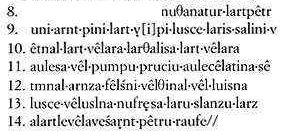
It
is supposed that the first word nuθana-tur is connected to
the verb пиθе
used together
with mal-e "they have
seen" ; for the
combination nuθe. male-c a tentative meaning "they have seen
and approved" has been suggested. It seems possible that all the persons
mentioned in the part are witnesses that can certify to the (sacred) act
described in the text.
The
following personal names are mentioned in a list that constitutes the essence of
this part:
|
number |
nomen |
second name |
third name |
|
1. |
Arnt |
Pêtru |
Raufe |
|
2. |
Arnt |
Pini |
|
|
3. |
Arnza |
Fêlśni |
Vêlθinal |
|
4. |
Aule |
Cêlatina |
Sêtmnal |
|
5. |
Laris |
Salini |
Vêtnal |
|
6. |
Lart |
Pêtruni |
|
|
7. |
Lart |
Vêlara |
Aulesa |
|
8. |
Lart |
Vêlara |
Larθalisa |
|
9 |
Lart |
V[i]pi (cf. Vipi-tur,a
collective in -tur,
in
an inscription preserved at
the Etruscan Academy, Cortona) |
Lusce
|
|
10. |
Laru |
Slanzu |
|
|
11. |
Larza |
Lartle |
|
|
12. |
Vêl / Vêlaveś (?) |
Avês (?) |
|
|
13. |
Vēl |
Luisna |
Lusce |
|
14. |
Vêl |
Pumpu |
Pruciu |
|
15. |
Vêl |
Usnla |
Nafresa |

Different
from the preceding part where only names of the adult males have been given and
the female names appear only in their derivatives in the cognomina and
metronomina, at the end of the part IV the phrase arntlei. pêtru-ś.
puia designates
"Arntlei, the wife (рuiа)
of Petru", and also sons (clan "son"- clen-iar) are
mentioned. The analytical construction with the verbal form ame
"was, would be" may
refer to the function of the females and sons who are not considered at the same
level as 15
men named earlier. Besides (16)
Arntlei and (17)
Pêtru
Scêvê
the following 3
people are mentioned in this part;
all of them have the third name
referring to the group of Laris (in cases 18
and 20 with
a preceding cognomen Cusu which reminds of the usage in the Part I:
|
number |
nomen |
second
name |
third
name |
|
18. |
Laris |
[C]usu |
L[a]risalisa |
|
19. |
Lariza |
|
Larisal |
|
20. |
Vêlχe |
Cusu |
Laris-al |
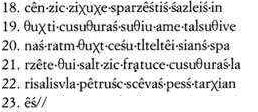
cên ziχ ziχ-u-χe "this
written text (lit. book) has been written"
cên
-
a
variant of
demonstrative pronominal forms cen/ ce(=?)hen (inscriptions
of Perugia)
ziχ
-
"liber", "writing,
book" (used in this part twice)
ziχ
«to write»
ziχ-u
"scribe,
writer"
ziχ-uι-χe
"has been
written" (the form occurs several times in different small inscriptions of
Cortona and in a similar context in the tablet of Perugia)
ziχ
ziχ-u-χe - figura etymologica
sparza
designates the
"tablet" according to Magnani; sparzeš-tiš is
an Ablative (-Ergative)
"by (with) a tablet".
tux-ti
means
"house"(?) according to Magnani (better: "building"?)
At
the end of this part the same person and the same group are mentioned as in the
Part I.

Some
of the proper names are close to those mentioned above (severely damaged names
that cannot be fully reconstructed are not included into the table):
number
nomen second
name third name
|
21. |
Arnt |
Luscni |
[A]rnθal |
|
22. |
[La]ris |
Cêlatina |
Lausa |
|
23. |
Laris |
Cusu |
Uslna |
|
24. |
Lart |
Cucrina |
Luasisa. |
|
25. |
Lart |
Pêtce |
Uslanl |
|
26. |
Lart |
Turmna |
Salina[l] |
|
27. |
Vêl[θur |
[Titlni] |
[Vêlθur]us |
|
28. |
Vêlχe |
Cusu |
Aule[sa] |
zil-αθ meχ-l raśna-l
"an
official (secretary/leader)
of the league of Etruscans (=the
people?)
řasna occurs
also in the first part of the text ( part
I)
zil-αθ - a variant of zil-αθ
aule salini cusu-al [ ]
An
end of a list giving the 3 names of a person (29).
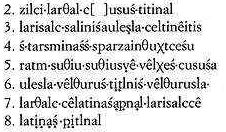
zil-ci
larθ-al cusu-ś titin-al laris-al-c salini-ś aule-sla
"during the (time of) the magistracy (zil-ci) of Lart(h) Cusu (son)
of Titinei and of Laris Salini (son) of Aule"
cf. zil-ci vêlusi
hulχniesi
(in 2 texts
of the tomb of the Scudi in Tarquinia)
zil-ci. Ceisiniesi ( bronze
tablet of Tarquinia)
2 names in the Part VII
repeat the names of the same persons (27-28 ) from the preceding part. A few new persons besides the 2
magistrates (30-31)
are introduced:
|
Number |
Nomen |
second
name |
third
name |
|
32. |
Laris-ale |
Cêlatina-ś. |
Pitln-al |
|
33. |
Larθ-al-c |
Cêlatina-ś |
Apnal |
celti nêitiśś. tarsminaśś "in
the area of the lake Trasimeno" (there are variants of the name like Trasimenus,
Trasumenm, Trasumennus, Tarsumenus. Ταρσσιμενα,
Τρσυμεννα,
Τρασυμενη
λιμην)
1.
2. Etr. zilat =
Hattic zilat
3. Etr. теχ
"league"= a peculiar Eblaite
term with the same meaning!
Brief
survey of the history: W.Thomsen (the problem of the Plural -r), N.Marr,
1. Etr. am-e «to be» :
Abkhazian
am-(ara) «
to be »:
Human
mann- «to be»> man-g-a «no, ther is not» (= Sumerogram
NU.GÁL)
<mann-+ negat.
suf. -g- +
Jussive -a, Neu 1996,
S. 258; Laroche Gloss.
Hourr.1980, p.165, RS quadr. 130
II 7 ; 12: ma-nu-ku=
NU «not» [I suppose that this Hur
negation has been borrowed into Hittite
of a late period
Hit. [UL] mаnqа ; on 2
examples of a non-negative use cf. CHD, 3.2, p. 176;
the texts were translated from Hurrian and
the contexts are not clear ];:
Hurr.
man- :Urart. man- «to be» < Hurr. - Urart. man-: Hinalug.- ma is
used with class prefixes and in compounds: Lezgian. «to be» > ama- «to
remain» (<*?ima Starostin-Nikolaev, p.210, the reconstruction
of an initial is doubtful), Tabasaran. imi-dixuz, Agul. Burk.
ame-xis, Rutul.
ma-a ,
Archin. imm(a)- eχ:as (in Lezgin
languages a defective verb used as an auxiliary form and in compounding),
Starosti-Diakonoff 1986,
S.21; Starostin-Nikolaev, p. 210:
comparison of Lezg.-Hinalug with
Hurr.-Urart man- (Abkhazian forms should be added)
2. Etr. cel- «earth»:
(I
believe that in Etruscan an old velar has been preserved while in NE Caucas there
is a trace of an ancient palatalization before a frontal vowel; as an
altrernative one may think of a group {Hushing Affricate +
Pharyngeal} >Etr. с
?):
Lezg.
D:il, Tabasaran. and Agul. žil, Rutul. And Tsaxur. oil,
Lak. š:allu
«earth» (Starostin-Nikolaev, p. 342:
NE Cauc
*čHälu)
If one supposes
that an Etr. initial consonant originally (at the time of prehistoric contact to
Pre-latin)
had been a dorsal (as NE
Cauc affricates and spirants,
then it becomes possible to compare it to Lat.
tellus «earth». The link of
this latin terni to Etruscan had
been suggested as early as by M.Breal on the base of similarity of Lat.
tellūmō
and Etr. lucumō
(Meillet- Ernout, p.679); in
a (highly) hypothetical Proto-Etr.- Proto-NE Cauc source of the word one may
reconstruct a final *-u- which might have been reflected in a prehistoric
Latin borrowing.
3. Etr. рuiа-
"wife": N
Cauc and Hattic: Hattic zzuwa-
"woman, wife"; Nakh *pstuw "woman, female">
Bacb. pstu; NW Cauc *pд-zV>Abkhaz.
Aps. Etruscan lost the
affricate/sibilant as in some other words cognate to N
Caucas (Etr. avil
: Hurrian
śawali-"year": N
Cauc *swerho "old,
age">Nakh *šo> Chechen šo
"year"
Nikolaev-Starostin, pp. 968-969;
the phonetic law has been
discovered 20
years ago vy several scholars
independently; cf.
probably also Etr.pulum-χνα
"stars"[= Phoen. hkkbm
],
inanimat: Ubykh upcluek? )
4. Etr. clan "son"
(animate g.): Hattic -kante (in a compound "the king's elder son=
prince"), Chechen klant "son"
(paccx'an klant "the
king's elder son= prince")< *kwVnt'V (I class)
5. Etr. ci
[ki] "3"=
Human kig
A
LARGER (_YENISSEYAN, SINO-TIBETAN+
Na-Dene?) macrofamily (Starostin)
Problematic
connections: Basque, Burushaski, Sumerian?
Etruscan
and Burushaski: Etr. zal "2": Burushaski al (Marr, 1) Iz
poezdki k evropejskim jafetidam.-Jafeticheskij
sbormik, III, s.24-25; 2) О chislitel'nyx
(K postanovke geneticheskogo voprosa.- Jazykovednye prolemy po chislitel'nym I
Leningrad, 1927, s.61-62)
The
oldest sphere of these languages and their dispersal; genetic data
(Cavalli-Sforza)